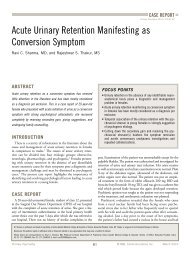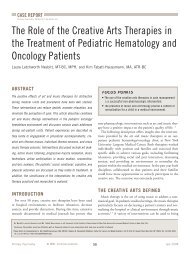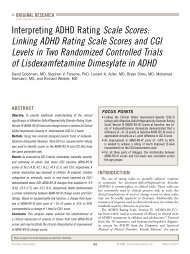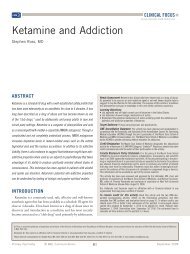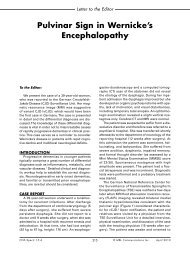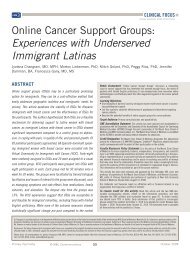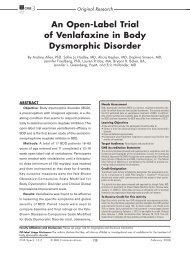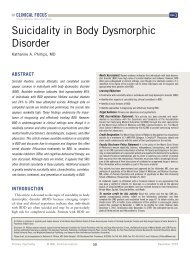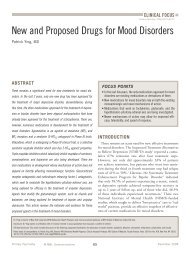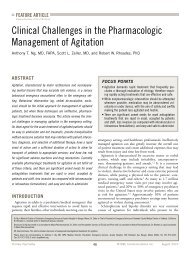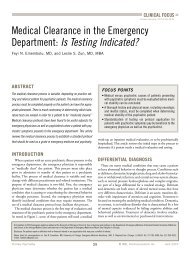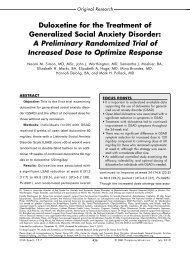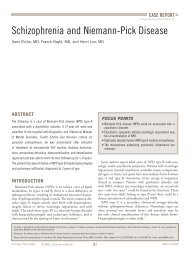Safety and Efficacy Pharmacogenomics in Pediatric ...
Safety and Efficacy Pharmacogenomics in Pediatric ...
Safety and Efficacy Pharmacogenomics in Pediatric ...
Create successful ePaper yourself
Turn your PDF publications into a flip-book with our unique Google optimized e-Paper software.
<strong>Safety</strong> <strong>and</strong> <strong>Efficacy</strong> <strong>Pharmacogenomics</strong><br />
<strong>in</strong> <strong>Pediatric</strong> Psychopharmacology<br />
Christopher A. Wall, MD, Cather<strong>in</strong>e Oldenkamp, MMSII, <strong>and</strong> Cosima Sw<strong>in</strong>tak, MD<br />
ABSTRACT<br />
Historically, cl<strong>in</strong>icians have had few resources beyond empiric tools<br />
derived from population-based treatment algorithms <strong>and</strong> patient/<br />
family <strong>in</strong>terviews to <strong>in</strong>form the “best choice” for psychopharmacolog-<br />
ic <strong>in</strong>tervention. Previously unappreciated <strong>in</strong>ter<strong>in</strong>dividual variance <strong>in</strong><br />
activity of cytochrome P450 enzymatic activity can lead to abnormal<br />
metabolism of many psychotropics <strong>and</strong> poor outcomes. Fortunately,<br />
advances <strong>in</strong> our underst<strong>and</strong><strong>in</strong>g <strong>and</strong> application of psychiatric phar-<br />
macogenomic <strong>in</strong>formation have the potential to improve the quality of<br />
medical care for children at the level of the <strong>in</strong>dividual prescription.<br />
INTRODUCTION<br />
A large number of children <strong>and</strong> adolescents present<strong>in</strong>g for<br />
health care are affected by mental illness <strong>and</strong> many require<br />
psychotropic medications as a component of their overall<br />
care. 1,2 Despite <strong>in</strong>creas<strong>in</strong>g choices <strong>in</strong> medication management,<br />
many of these patients still experience poor outcomes<br />
related to <strong>in</strong>adequate medication response <strong>and</strong> significant<br />
adverse drug events (ADEs). 3 Given ongo<strong>in</strong>g shortages <strong>in</strong> the<br />
specialty of child <strong>and</strong> adolescent psychiatry, 4 the considerable<br />
challenge of prescrib<strong>in</strong>g psychotropics <strong>in</strong> the pediatric<br />
population is often managed by adult psychiatrists, family<br />
physicians, <strong>and</strong> pediatricians. In consider<strong>in</strong>g whether a<br />
medication is the “right” one for a given patient, all cl<strong>in</strong>icians<br />
must weigh not only issues such as the potential for side<br />
effects, family responses to similar psychotropic medications,<br />
<strong>and</strong> the nature <strong>and</strong> <strong>in</strong>tensity of the patient’s illness, but also<br />
psychosocial concerns. This is a process which is complicated<br />
by the knowledge that an <strong>in</strong>correct choice could result <strong>in</strong><br />
Primary Psychiatry<br />
53<br />
<strong>in</strong>tolerable side effects, poor efficacy, <strong>and</strong> ultimately—perhaps<br />
most importantly—a negative view towards medication<br />
that may have proved helpful. Lack of efficacy <strong>and</strong> ADEs are<br />
frequently cited as reasons for noncompliance <strong>in</strong> pediatric<br />
psychopharmacology.<br />
Currently, children who are treated without the benefit of<br />
<strong>in</strong>dividualized molecular genotyp<strong>in</strong>g have only a 60% chance<br />
of successful long-term treatment. 5 Fortunately, advances <strong>in</strong><br />
our underst<strong>and</strong><strong>in</strong>g <strong>and</strong> application of <strong>in</strong>dividual pharmacogenetic<br />
profiles have the potential to improve the quality<br />
of medical care for children at the level of the <strong>in</strong>dividual<br />
prescription. 6 Pickar 7 has suggested that there is no specialty<br />
where the need for pharmacogenetics seems more compell<strong>in</strong>g<br />
than for psychiatry. Psychiatric pharmacogenomics is<br />
an emerg<strong>in</strong>g tool to assist cl<strong>in</strong>icians <strong>in</strong> develop<strong>in</strong>g strategies<br />
to personalize treatment <strong>and</strong> tailor therapy to <strong>in</strong>dividual<br />
patients, with the goal of optimiz<strong>in</strong>g efficacy <strong>and</strong> safety<br />
through better underst<strong>and</strong><strong>in</strong>g of genetic variability <strong>and</strong> its<br />
<strong>in</strong>fluence on drug response. This article provides discussion<br />
of the role emerg<strong>in</strong>g pharmacogenomic advancement is<br />
Dr. Wall is <strong>in</strong>structor of psychiatry <strong>and</strong> consultant <strong>in</strong> child psychiatry <strong>and</strong> Dr. Sw<strong>in</strong>tak is <strong>in</strong>structor <strong>in</strong> psychiatry <strong>and</strong> senior associate consultant <strong>in</strong> child psychiatry, both <strong>in</strong> the Department of Psychiatry <strong>and</strong><br />
Psychology at the Mayo Cl<strong>in</strong>ic <strong>in</strong> Rochester, M<strong>in</strong>nesota. Ms. Oldenkamp is a medical student at the Mayo Medical School <strong>in</strong> Rochester.<br />
Disclosure: The authors report no affiliation with or f<strong>in</strong>ancial <strong>in</strong>terest <strong>in</strong> any organization that may pose a conflict of <strong>in</strong>terest.<br />
FOCUS POINTS<br />
CLINICAL FOCUS<br />
Primary Psychiatry. 2010;17(5):53-58<br />
• Advances <strong>in</strong> pharmacogenomics have the potential to<br />
improve the quality of medical care for children at the level<br />
of the <strong>in</strong>dividual prescription.<br />
• Nearly 80% of all drugs <strong>in</strong> use today, along with most psychotropics,<br />
are metabolized via testable metabolic pathways.<br />
• Children <strong>and</strong> adolescents with metabolic polymorphisms<br />
may be at greater risk for adverse drug events than children<br />
with normal metabolism.<br />
• <strong>Pediatric</strong> psychotropic prescribers must consider treatmentresistant<br />
patients as potential abnormal metabolizers.<br />
Please direct all correspondence to: Christopher A. Wall, MD, Instructor of Psychiatry, Consultant–Child Psychiatry, Dept of Psychiatry <strong>and</strong> Psychology, Mayo Cl<strong>in</strong>ic, 200 1st St, SW, Rochester, MN 55905;<br />
Tel: 507-284-3352; Fax: 507-533-5353; E-mail: wall.chris@mayo.edu.<br />
© MBL Communications Inc. May 2010
C.A. Wall, C. Oldenkamp, C. Sw<strong>in</strong>tak<br />
play<strong>in</strong>g <strong>in</strong> the cl<strong>in</strong>ical practice of <strong>in</strong>dividualized psychopharmacology:<br />
mov<strong>in</strong>g away from “trial <strong>and</strong> error” prescriptions<br />
to <strong>in</strong>dividualized prescrib<strong>in</strong>g. The article also highlights the<br />
grow<strong>in</strong>g literature <strong>and</strong> adoption of pharmacogenomic pr<strong>in</strong>ciples<br />
guid<strong>in</strong>g modern psychotropic prescrib<strong>in</strong>g practices<br />
focus<strong>in</strong>g on the pediatric population.<br />
BACKGROUND OF PSYCHIATRIC<br />
PHARMACOGENOMICS<br />
Psychiatric pharmacogenomics is the study of how gene<br />
variations <strong>in</strong>fluence the responses of a patient to treatment<br />
with psychotropics. The most commonly studied cytochrome<br />
P450 (CYP) enzymes <strong>in</strong>clude 2D6, 2C19, <strong>and</strong> 2C9.<br />
Polymorphisms <strong>and</strong> gene duplications <strong>in</strong> these enzymes<br />
account for the most frequent variations <strong>in</strong> phase I metabolism<br />
of drugs s<strong>in</strong>ce nearly 80% of all drugs <strong>in</strong> use today, along<br />
with most psychotropics (Tables 1 <strong>and</strong> 2), 8 are metabolized<br />
via these pathways. 9 It should also be noted that genetics may<br />
account for 20% to 95% percent of variability <strong>in</strong> drug disposition<br />
<strong>and</strong> effects. 10<br />
Historic <strong>and</strong> current literature divides metabolic phenotypes<br />
<strong>in</strong>to four basic categories. These categories presented<br />
from least to most efficient metabolism are as follows: poor<br />
metabolism (PM; essentially no metabolism at a given<br />
enzyme pathway), <strong>in</strong>termediate metabolism (IM), extensive<br />
TABLE 1<br />
ANTIDEPRESSANT METABOLISM BY CYP ENZYME 8<br />
CYP<br />
Enzyme<br />
Primarily<br />
Metabolized<br />
2D6 desipram<strong>in</strong>e<br />
doxep<strong>in</strong><br />
fluoxet<strong>in</strong>e<br />
nortriptyl<strong>in</strong>e<br />
paroxet<strong>in</strong>e<br />
venlafax<strong>in</strong>e<br />
2C19 amitriptyl<strong>in</strong>e<br />
citalopram<br />
clomipram<strong>in</strong>e<br />
escitalopram<br />
Substantially<br />
Metabolized<br />
amitriptyl<strong>in</strong>e<br />
bupropion<br />
duloxet<strong>in</strong>e<br />
imipram<strong>in</strong>e<br />
mirtazap<strong>in</strong>e<br />
trazodone<br />
doxep<strong>in</strong><br />
imipram<strong>in</strong>e<br />
moclobemide<br />
notriptyl<strong>in</strong>e<br />
sertral<strong>in</strong>e<br />
1A2 fluvoxam<strong>in</strong>e clomipram<strong>in</strong>e<br />
duloxet<strong>in</strong>e<br />
imipram<strong>in</strong>e<br />
2C9 None amitriptyl<strong>in</strong>e<br />
fluoxet<strong>in</strong>e<br />
M<strong>in</strong>imally<br />
Metabolized<br />
citalopram<br />
escitalopram<br />
fluvoxam<strong>in</strong>e<br />
sertral<strong>in</strong>e<br />
venlafax<strong>in</strong>e<br />
amitriptyl<strong>in</strong>e<br />
mirtazap<strong>in</strong>e<br />
sertral<strong>in</strong>e<br />
Mrazek D. Psychiatric <strong>Pharmacogenomics</strong>. New York, NY: Oxford University Press; 2010.<br />
Repr<strong>in</strong>ted with permission from Oxford University Press. Copyright 2010.<br />
CYP=cytochrome P450.<br />
Wall CA, Oldenkamp C, Sw<strong>in</strong>tak C. Primary Psychiatry. Vol 17, No 5. 2010.<br />
metabolism (EM; essentially “normal” metabolism), <strong>and</strong><br />
ultra-rapid metabolism (UM). For the purpose of discussion,<br />
this article will highlight safety <strong>and</strong> efficacy concerns related<br />
to the 15% to 25% of pediatric patients that are either PM<br />
or UM metabolizers. 11<br />
SAFETY AND EFFICACY IN ABNORMAL<br />
METABOLIZERS<br />
The two primary tenets considered <strong>in</strong> all pediatric prescriptions<br />
are safety <strong>and</strong> efficacy, <strong>and</strong> both can be more precisely<br />
addressed through pharmacogenomics. “<strong>Safety</strong> pharmacogenomics”<br />
aims to avoid ADEs <strong>and</strong> side effects by identify<strong>in</strong>g<br />
<strong>in</strong>dividuals who are likely to have difficulty with certa<strong>in</strong><br />
medications due to either <strong>in</strong>creased activity of an enzymatic<br />
pathway (UMs), or lack of activity (PMs). “<strong>Efficacy</strong> pharmacogenomics”<br />
attempts to predict an <strong>in</strong>dividual’s likely response<br />
to a medication at the outset of treatment. 12<br />
Inter<strong>in</strong>dividual variance of activity of CYP enzymes can lead<br />
to abnormal metabolism of most antidepressants (Table 1) <strong>and</strong><br />
antipsychotics (Table 2). These medications have been associated<br />
with a variety of ADEs, rang<strong>in</strong>g from milder side effects,<br />
such as activation, irritability, sexual dysfunction, <strong>and</strong> sedation,<br />
to more significant ADEs, such as weight ga<strong>in</strong>, extrapyramidal<br />
symptoms, metabolic syndrome, hyperprolact<strong>in</strong>emia,<br />
manic-<strong>in</strong>duction, neuroleptic malignant syndrome, <strong>and</strong> even<br />
suicidality. 13 Children <strong>and</strong> adolescents with polymorphisms<br />
lead<strong>in</strong>g to abnormal drug metabolism may be at greater risk for<br />
some of these ADEs than children with normal metabolism, as<br />
medications adm<strong>in</strong>istered at normal therapeutic doses to poor<br />
metabolizers may result <strong>in</strong> toxicity, <strong>and</strong> consequently ADEs.<br />
Conversely, UMs may not atta<strong>in</strong> therapeutic plasma levels on<br />
typical therapeutic doses of medications <strong>and</strong> the treatment may<br />
TABLE 2<br />
ANTIPSYCHOTIC METABOLISM BY CYP ENZYME 8<br />
CYP<br />
Enzyme<br />
Primarily<br />
Metabolized<br />
2D6 chlorpromaz<strong>in</strong>e<br />
haloperidol<br />
perphenaz<strong>in</strong>e<br />
risperidone<br />
thioridaz<strong>in</strong>e<br />
Substantially<br />
Metabolized<br />
aripiprazole<br />
olanzap<strong>in</strong>e<br />
M<strong>in</strong>imally<br />
Metabolized<br />
clozap<strong>in</strong>e<br />
quetiap<strong>in</strong>e<br />
ziprasidone<br />
2C19 None clozap<strong>in</strong>e thioridaz<strong>in</strong>e<br />
1A2 clozap<strong>in</strong>e<br />
olanzap<strong>in</strong>e<br />
chlorpromaz<strong>in</strong>e haloperidol<br />
thioridaz<strong>in</strong>e<br />
Mrazek D. Psychiatric <strong>Pharmacogenomics</strong>. New York, NY: Oxford University Press; 2010.<br />
Repr<strong>in</strong>ted with permission from Oxford University Press. Copyright 2010.<br />
CYP=cytochrome P450.<br />
Wall CA, Oldenkamp C, Sw<strong>in</strong>tak C. Primary Psychiatry. Vol 17, No 5. 2010.<br />
Primary Psychiatry 54<br />
© MBL Communications Inc. May 2010
fail or lead to rapid conversion of prodrug to potentially toxic<br />
active metabolites.<br />
Table 3 13-51 <strong>in</strong>cludes a list of ADEs that have been l<strong>in</strong>ked to<br />
abnormal metabolism of psychotropics by at least one study<br />
<strong>in</strong>volv<strong>in</strong>g abnormal metabolizers. As pharmacogenomic test<strong>in</strong>g<br />
is a relatively new technology, not many studies have been<br />
performed <strong>in</strong>vestigat<strong>in</strong>g these l<strong>in</strong>ks, but identify<strong>in</strong>g the at-risk<br />
population <strong>in</strong> advance could do much to positively affect<br />
quality of life, <strong>in</strong>crease compliance with medications, <strong>and</strong><br />
even circumvent death <strong>in</strong> rare cases. Pharmacogenomic test<strong>in</strong>g<br />
has the potential to offer a more complete, <strong>in</strong>dividualized<br />
risk profile enabl<strong>in</strong>g tailored choices of medication with doses<br />
appropriately adjusted for <strong>in</strong>dividual metabolism <strong>and</strong> advanced<br />
screen<strong>in</strong>g for the propensity of certa<strong>in</strong> undesirable effects.<br />
SAFETY AND EFFICACY IMPLICATIONS<br />
IN POOR METABOLISM<br />
Weight Ga<strong>in</strong> <strong>and</strong> Metabolic Syndrome<br />
There is no doubt that weight ga<strong>in</strong> can be detrimental to a<br />
young person’s physical <strong>and</strong> mental health <strong>and</strong> can exacerbate<br />
problems with self-esteem dur<strong>in</strong>g all developmental stages.<br />
Obesity, which is common among schizophrenic patients, 52<br />
may be further exacerbated by antipsychotics. It has been shown<br />
that decreased metabolism due to variations <strong>in</strong> several CYP<br />
genes may contribute to a patient’s risk profile while tak<strong>in</strong>g an<br />
antipsychotic. For example, decreased metabolism at CYP1A2,<br />
which is known to be <strong>in</strong>volved <strong>in</strong> the metabolism of some antipsychotics,<br />
is associated with <strong>in</strong>creased risk for weight ga<strong>in</strong> <strong>and</strong> a<br />
TABLE 3<br />
ADVERSE EFFECTS ASSOCIATED WITH ABNORMAL METAB-<br />
OLISM 13-51<br />
Reduced metabolism (ie, poor) Increased metabolism (ie, ultrarapid)<br />
EPS 14-22 Opioid toxicity 23-33<br />
Tardive dysk<strong>in</strong>esia 14,34-36 Nausea 37<br />
Oversedation 38-40 Paradoxical excitation 41<br />
Cardiovascular complications<br />
(ie, tachycardia, hypertension,<br />
hypotension) 46,47<br />
Weight ga<strong>in</strong> 46,47 Suicidality 13<br />
Neuroleptic malignant syndrome 48-50<br />
Seroton<strong>in</strong> syndrome 51<br />
Suicidality 22,51<br />
EPS=extrapyramidal symptoms.<br />
Treatment nonresponse 43-45<br />
Wall CA, Oldenkamp C, Sw<strong>in</strong>tak C. Primary Psychiatry. Vol 17, No 5. 2010.<br />
<strong>Safety</strong> <strong>and</strong> <strong>Efficacy</strong> <strong>Pharmacogenomics</strong> <strong>in</strong> <strong>Pediatric</strong> Psychopharmacology<br />
cluster of cl<strong>in</strong>ical features <strong>in</strong>clud<strong>in</strong>g <strong>in</strong>creased visceral adiposity,<br />
hyperglycemia, hypertension, <strong>and</strong> dyslipidemia known as “metabolic<br />
syndrome.” 53 Prevalence of metabolic syndrome is higher<br />
<strong>in</strong> women than it is <strong>in</strong> men as demonstrated <strong>in</strong> the Cl<strong>in</strong>ical<br />
Antipsychotic Trials of Intervention Effectiveness schizophrenia<br />
trial. 53 Lower activity of CYP1A2 may also contribute to the<br />
risk for metabolic syndrome by lead<strong>in</strong>g to <strong>in</strong>creased serum<br />
concentrations of antipsychotics at st<strong>and</strong>ard doses. Children,<br />
especially young females, may be more susceptible to weight<br />
ga<strong>in</strong> while on antipsychotics, 53-55 <strong>and</strong> weight ga<strong>in</strong> may lead to<br />
noncompliance <strong>and</strong> subsequent relapse. 52-56<br />
All of this evidence suggests that pediatric patients are likely<br />
to be at <strong>in</strong>creased risk of weight ga<strong>in</strong> <strong>and</strong> metabolic syndrome if<br />
carry<strong>in</strong>g polymorphisms associated with decreased or absent 1A2<br />
activity. Identify<strong>in</strong>g poor metabolizers at this <strong>and</strong> other genes<br />
associated with atypical antipsychotic metabolism could allow a<br />
physician to be better <strong>in</strong>formed of all risks when prescrib<strong>in</strong>g, <strong>and</strong><br />
heighten awareness related to early signs of metabolic syndrome<br />
or weight ga<strong>in</strong>. This may be especially pert<strong>in</strong>ent to young female<br />
patients, who appear to carry the most risk.<br />
Extrapyramidal Symptoms<br />
Extrapyramidal symptoms (EPS) are frequent <strong>and</strong> serious<br />
acute adverse reactions to antipsychotics. These symptoms<br />
<strong>in</strong>clude pseudopark<strong>in</strong>sonism, acute dystonia, akathisia, <strong>and</strong><br />
tardive dysk<strong>in</strong>esia, 34 which may be permanent even after<br />
removal of the drug.<br />
Several hypotheses <strong>and</strong> studies <strong>in</strong>dicate that PM at CYP2D6,<br />
which metabolizes several of the typical <strong>and</strong> atypical psychotropics,<br />
may <strong>in</strong>crease the risk of develop<strong>in</strong>g EPS. Poor<br />
CYP2D6 metabolizers are likely to have higher than average<br />
plasma concentrations of neuroleptics with an <strong>in</strong>creased risk<br />
for develop<strong>in</strong>g EPS, <strong>in</strong>clud<strong>in</strong>g tardive dysk<strong>in</strong>esia. 14,34,57-59 PM<br />
or <strong>in</strong>hibition of CYP2D6 may be l<strong>in</strong>ked to the <strong>in</strong>duction of<br />
EPS. CYP2D6 <strong>in</strong> the bra<strong>in</strong> is <strong>in</strong>volved <strong>in</strong> the metabolism of<br />
dopam<strong>in</strong>e <strong>and</strong> has a possible functional association with the<br />
dopam<strong>in</strong>e transporter. 59,60 Several selective seroton<strong>in</strong> reuptake<br />
<strong>in</strong>hibiters <strong>and</strong> tricyclic antidepressants <strong>in</strong>hibit CYP2D6, as do<br />
a number of non-psychotropic drugs such as qu<strong>in</strong>id<strong>in</strong>e. Methy<br />
lphenyltetrahydropyrid<strong>in</strong>e, a dopam<strong>in</strong>e neurotox<strong>in</strong> able to produce<br />
Park<strong>in</strong>sonism, is metabolized by 2D6 <strong>and</strong> is also a 2D6<br />
<strong>in</strong>hibitor. V<strong>and</strong>el <strong>and</strong> colleagues 59 concluded that <strong>in</strong>hibition of<br />
CYP2D6 may be <strong>in</strong>volved <strong>in</strong> the genesis of EPS observed <strong>in</strong><br />
treatment with 2D6 substrate psychotropics.<br />
It follows that poor CYP2D6 metabolizers may be at <strong>in</strong>creased<br />
risk for EPS while on certa<strong>in</strong> antidepressants due to high plasma<br />
levels. 59 Indeed, it has been shown that there is a significant association<br />
between EPS <strong>and</strong> the CYP2D6*4 <strong>and</strong> CYP2D6*6 polymorphisms<br />
that are both associated with the poor metabolizer<br />
phenotype. 61,62 Furthermore, there may be a relationship between<br />
the degree of impaired CYP2D6 activity <strong>and</strong> the severity of EPS<br />
dur<strong>in</strong>g neuroleptic treatment. 34 One study 14 demonstrat<strong>in</strong>g that<br />
Primary Psychiatry 55<br />
© MBL Communications Inc. May 2010
C.A. Wall, C. Oldenkamp, C. Sw<strong>in</strong>tak<br />
the development of EPS or tardive dysk<strong>in</strong>esia while on antipsychotic<br />
medication is significantly more frequent among PMs<br />
than among matched IM <strong>and</strong> EM patients, also found a significantly<br />
higher prevalence of noncompliance among the same PM<br />
patients. These f<strong>in</strong>d<strong>in</strong>gs highlight the importance of identify<strong>in</strong>g<br />
those at greater risk for experienc<strong>in</strong>g these serious ADEs.<br />
Neuroleptic Malignant Syndrome<br />
Neuroleptic malignant syndrome (NMS) is a life-threaten<strong>in</strong>g<br />
ADE associated with antipsychotics, antidepressants, <strong>and</strong><br />
other psychotropics. Signs of NMS <strong>in</strong>clude hyperthermia,<br />
EPS, altered consciousness, fluctuat<strong>in</strong>g blood pressure, <strong>in</strong>cont<strong>in</strong>ence,<br />
<strong>and</strong> dyspnea. 48,63,64 While some studies were unable to<br />
f<strong>in</strong>d a significant l<strong>in</strong>k between reduced function of CYP2D6<br />
<strong>and</strong> NMS, 65,66 more recent case studies suggest pharmacogenomic<br />
factors cannot yet be excluded as risk factors for this<br />
serious condition. In two separate case studies, four patients<br />
who developed NMS were later determ<strong>in</strong>ed to have mutations<br />
<strong>in</strong> CYP2D6 conferr<strong>in</strong>g the PM phenotype. 48 It was concluded<br />
that while not all NMS patients have this poor metabolizer<br />
phenotype, poor metabolizers at CYP2D6 may be at <strong>in</strong>creased<br />
risk for develop<strong>in</strong>g NMS. 49<br />
Hyperprolact<strong>in</strong>emia<br />
Conventional antipsychotics <strong>and</strong> certa<strong>in</strong> atypical antipsychotics,<br />
such as risperidone, can cause significant elevations<br />
<strong>in</strong> prolact<strong>in</strong>. 53 For risperidone, <strong>in</strong>creases <strong>in</strong> prolact<strong>in</strong> levels are<br />
dose related. 53,67 Though no studies have yet been conducted<br />
to show a l<strong>in</strong>k between PM phenotypes <strong>and</strong> ADEs related to<br />
hyperprolact<strong>in</strong>emia, this l<strong>in</strong>k rema<strong>in</strong>s not only possible, but an<br />
important consideration <strong>in</strong> the pediatric population. Amongst<br />
other potential developmental concerns, complications from<br />
early hyperprolact<strong>in</strong>emia may <strong>in</strong>clude bone loss, which <strong>in</strong> turn<br />
could lead to significant consequences upon reach<strong>in</strong>g adulthood.<br />
Furthermore, if this <strong>in</strong>crease <strong>in</strong> prolact<strong>in</strong> is dose related, PMs<br />
may have elevated risk as they may experience higher serum<br />
concentrations of poorly metabolized medication.<br />
Additional Considerations<br />
Prescribers should also bear <strong>in</strong> m<strong>in</strong>d that over sedation,<br />
postural hypotension, <strong>and</strong> cardiovascular complications may<br />
be additional significant concerns <strong>in</strong> poor metabolizers. 68<br />
Likewise, as cl<strong>in</strong>icians follow their natural tendency to optimize<br />
dos<strong>in</strong>g <strong>in</strong> their treatment of psychiatric symptoms, it may<br />
be helpful to remember that, <strong>in</strong> the PM population, so called<br />
“somatic symptoms” associated with psychiatric diagnoses<br />
(<strong>and</strong> subsequent treatment) may <strong>in</strong> fact be medication <strong>in</strong>tolerance<br />
exacerbated by dose titration. Without knowledge of the<br />
patient’s metabolic phenotype, the cl<strong>in</strong>ician must “guess” as to<br />
the cause of these symptoms <strong>and</strong> may <strong>in</strong>correctly conclude that<br />
the patient is just “anxious” or “dramatic.” Furthermore, the<br />
cl<strong>in</strong>ician must also wonder whether or not the patient will be<br />
able to adequately tolerate the next medication choice.<br />
SAFETY AND EFFICACY IMPLICATIONS<br />
IN ULTRA-RAPID METABOLISM<br />
UMs present their own set of treatment challenges as they may<br />
not atta<strong>in</strong> therapeutic plasma levels on normal doses of medications,<br />
<strong>and</strong> thus treatment may have a higher propensity to fail. 69<br />
For example, a recent Swedish autopsy study 13 found that among<br />
those who died of suicide, there was a higher number carry<strong>in</strong>g<br />
>2 active CYP2D6 genes (UM phenotype) as compared with<br />
those who died of natural causes. Postulated explanations for this<br />
f<strong>in</strong>d<strong>in</strong>g <strong>in</strong>clude accumulation of higher levels of metabolites at a<br />
faster rate which is a known risk of UM. This buildup may lead<br />
to adverse drug reactions if the metabolite is active or toxic. It<br />
could also be argued that <strong>in</strong> this population, UMs did not reach<br />
the desired therapeutic concentration of their prescribed medications<br />
<strong>and</strong> thus had not been treated effectively. This hypothesis<br />
is supported by Kawanishi <strong>and</strong> colleagues 43 who found UMs<br />
as more likely to fail to respond to antidepressants. The ultrarapid<br />
metabolizers <strong>in</strong> the study also had the worst scores on the<br />
Hamilton Rat<strong>in</strong>g Scale for Depression lead<strong>in</strong>g the authors to<br />
conclude that ultra rapid metabolism may be a risk factor for<br />
persistent mood disorders.<br />
Case studies <strong>in</strong> UMs suggest that diphenhydram<strong>in</strong>e may be<br />
converted to a compound which causes paradoxical excitation<br />
due to the abnormally high CYP2D6 activity. 41 More serious<br />
consequences might be seen <strong>in</strong> children treated with other<br />
medications like code<strong>in</strong>e whose ultra-rapid conversion might<br />
result <strong>in</strong> toxic accumulation of morph<strong>in</strong>e lead<strong>in</strong>g to death. 23<br />
It follows that UMs could be at <strong>in</strong>creased risk of ADEs from<br />
higher levels of toxic or active metabolites from psychotropics.<br />
DISCUSSION<br />
To date, much of the available literature on pharmacogenomic<br />
test<strong>in</strong>g <strong>in</strong> the pediatric population has focused on the spectrum<br />
of efficacy related to cancer treatments. 70-75 Impressive results <strong>in</strong><br />
leukemia remission rates have been described as partly due to<br />
advancements <strong>in</strong> pharmacogenomically derived <strong>in</strong>dividualized<br />
prescrib<strong>in</strong>g practices. Cheok <strong>and</strong> colleagues 70 highlighted the<br />
progress made <strong>in</strong> the treatment of acute lymphoblastic leukemia<br />
<strong>in</strong> children not<strong>in</strong>g the disease as be<strong>in</strong>g lethal 4 decades ago to<br />
current cure rates exceed<strong>in</strong>g 80%. This progress is largely due to<br />
the optimization of exist<strong>in</strong>g treatment modalities rather than the<br />
discovery of new antileukemic agents. The literature regard<strong>in</strong>g<br />
the pharmacogenomics of asthma treatment <strong>and</strong> research design<br />
has also been quite active <strong>in</strong> the pediatric population <strong>in</strong> the past<br />
few years. 76-83 In both cancer <strong>and</strong> asthma research, there are clear<br />
Primary Psychiatry 56<br />
© MBL Communications Inc. May 2010
outcomes <strong>and</strong> endpo<strong>in</strong>ts to def<strong>in</strong>e treatment response <strong>and</strong> the<br />
role that <strong>in</strong>ter<strong>in</strong>dividual variability plays.<br />
Historically, the process of <strong>in</strong>itiat<strong>in</strong>g psychopharmacologic<br />
agents <strong>in</strong> the child <strong>and</strong> adolescent population has been<br />
empirically based <strong>and</strong> one <strong>in</strong> which the cl<strong>in</strong>ician considers<br />
many variables <strong>in</strong>clud<strong>in</strong>g age, gender, access to health care,<br />
<strong>and</strong> ability to rema<strong>in</strong> compliant with the proposed treatment.<br />
Frequently factored <strong>in</strong>to this consideration are quasi-genetic<br />
questions relat<strong>in</strong>g to family history of illness as well as family<br />
history of medication response. Until very recently, the use of<br />
family history has been the only tool available to better underst<strong>and</strong><br />
genetic makeup <strong>and</strong> its resultant <strong>in</strong>terplay with efficacy<br />
<strong>and</strong> ADEs. In fact, as early as the 19th century, Holmes 84<br />
commented that, “All medications are directly harmful; the<br />
question is whether they are <strong>in</strong>directly beneficial.” Fortunately,<br />
unlike <strong>in</strong> Holmes’ day, we now have the potential capability to<br />
resolve that very question; pharmacogenomic test<strong>in</strong>g can help<br />
determ<strong>in</strong>e <strong>in</strong> advance whether an <strong>in</strong>dividual will respond favorably.<br />
Ongo<strong>in</strong>g central nervous system maturation coupled with<br />
an <strong>in</strong>creased risk for ADEs makes the utility of this advance<br />
most relevant <strong>in</strong> pediatric psychopharmacology.<br />
Though most prescrib<strong>in</strong>g <strong>in</strong> pediatric psychiatry is still off label,<br />
treatment algorithms do currently exist for most classes of psychotropics.<br />
Unfortunately, none of these algorithms base their recommendations<br />
on psychiatric pharmacogenomics. Furthermore,<br />
s<strong>in</strong>ce dos<strong>in</strong>g recommendations are based on “normal” metabolizers,<br />
they do not <strong>in</strong>clude the estimated 15% to 25% of the population<br />
who is either UMs (<strong>and</strong> therefore at much higher risk for<br />
resultant noncompliance due to never reach<strong>in</strong>g therapeutic <strong>and</strong>/or<br />
beneficial levels) or poor with non-compliance result<strong>in</strong>g from<br />
ADEs. These outliers, who frequently end up <strong>in</strong> treatment-resistant<br />
categories of patients, might have entirely different outcomes<br />
if medication management were tailored to their genetic—<strong>and</strong><br />
therefore most fundamental—needs.<br />
When consider<strong>in</strong>g the “stakes” <strong>in</strong>volved <strong>in</strong> the early patientphysician-family<br />
relationship, it is clear that prescrib<strong>in</strong>g with<br />
improved confidence, <strong>and</strong> less risk of ADEs, will pay significant<br />
dividends. For example, if a cl<strong>in</strong>ician thoughtfully considers<br />
not only the symptoms <strong>in</strong>volved <strong>in</strong> the patient’s illness<br />
process, but also the likelihood that the patient will experience<br />
difficulties with certa<strong>in</strong> medications, the patient <strong>and</strong> family<br />
cannot help but be appreciative of the efforts <strong>in</strong>volved at def<strong>in</strong><strong>in</strong>g<br />
their particular risks. This transparency of process <strong>and</strong> subsequent<br />
conversations about the role for medications will allow<br />
for greater trust <strong>and</strong> a sense of improved objectivity.<br />
Widespread adoption of pharmacogenomic test<strong>in</strong>g will be<br />
hampered by several factors <strong>in</strong>clud<strong>in</strong>g costs, limited sample<br />
sizes <strong>in</strong> research reports, <strong>and</strong> <strong>in</strong>gra<strong>in</strong>ed practice habits fueled by<br />
underst<strong>and</strong>able skepticism <strong>and</strong> access challenges. Each of these<br />
issues will need to be <strong>in</strong>dividually addressed <strong>and</strong> overcome <strong>in</strong> the<br />
foreseeable future. Several academic medical centers are <strong>in</strong>corporat<strong>in</strong>g<br />
this form of test<strong>in</strong>g <strong>in</strong>to the comprehensive biopsycho-<br />
<strong>Safety</strong> <strong>and</strong> <strong>Efficacy</strong> <strong>Pharmacogenomics</strong> <strong>in</strong> <strong>Pediatric</strong> Psychopharmacology<br />
social workup <strong>and</strong> results appear promis<strong>in</strong>g. 11,85 Today, the cost<br />
of the genotyp<strong>in</strong>g of a s<strong>in</strong>gle gene varies between $300–$700<br />
depend<strong>in</strong>g upon the complexity of the variants that are be<strong>in</strong>g<br />
identified. Fortunately, panels of <strong>in</strong>formative genes can now be<br />
ordered for between $800–$1,500. With the rapid improvement<br />
<strong>in</strong> sequenc<strong>in</strong>g technologies that is now occurr<strong>in</strong>g, these costs will<br />
<strong>in</strong>evitably decrease <strong>in</strong> the near future.<br />
As psychiatric illnesses are <strong>in</strong>creas<strong>in</strong>gly recognized <strong>and</strong><br />
treated <strong>in</strong> the pediatric population, cl<strong>in</strong>icians now have access<br />
to an emerg<strong>in</strong>g set of pharmacogenomic pr<strong>in</strong>ciples to guide<br />
their prescrib<strong>in</strong>g practices. The primary pr<strong>in</strong>ciple is to use<br />
pharmacogenomic test<strong>in</strong>g to <strong>in</strong>crease the safety of psychotropics.<br />
A second pr<strong>in</strong>ciple is to use test<strong>in</strong>g to identify medications<br />
that are unlikely to be effective. The ultimate goal of pharmacogenomic<br />
test<strong>in</strong>g is to f<strong>in</strong>d the “right medication” on the first<br />
try. As pharmacogenomic test<strong>in</strong>g becomes more sophisticated,<br />
it will be possible to ab<strong>and</strong>on “trial <strong>and</strong> error” strategies <strong>and</strong><br />
beg<strong>in</strong> to provide <strong>in</strong>dividualized care utiliz<strong>in</strong>g metabolic <strong>and</strong><br />
receptor pharmacogenomics. Us<strong>in</strong>g composite data, cl<strong>in</strong>icians<br />
will have an unprecedented degree of molecular <strong>in</strong>formation<br />
available to help them choose effective medication-based treatments<br />
while m<strong>in</strong>imiz<strong>in</strong>g the potential for ADEs.<br />
CONCLUSION<br />
As cl<strong>in</strong>icians cont<strong>in</strong>ue to treat pediatric patients with psychotropics,<br />
every relevant cl<strong>in</strong>ical observation <strong>and</strong> laboratory<br />
assessment should be considered to <strong>in</strong>crease the likelihood<br />
of achiev<strong>in</strong>g remission of symptoms with m<strong>in</strong>imal ADEs.<br />
Review<strong>in</strong>g the results of pharmacogenomic test<strong>in</strong>g prior to<br />
writ<strong>in</strong>g an <strong>in</strong>itial prescription now provides cl<strong>in</strong>icians useful<br />
<strong>in</strong>dividualized data that can be reviewed with the patient <strong>and</strong><br />
family to <strong>in</strong>form them about the role that metabolism may<br />
play <strong>in</strong> treatment response as well as the possibility of ADEs. It<br />
is the authors’ belief that pharmacogenomic test<strong>in</strong>g has a significant<br />
role <strong>in</strong> modern psychopharmacologic practice <strong>and</strong> that<br />
the associated expenses are already outweighed by the potential<br />
benefits of more <strong>in</strong>dividualized prescriptions. PP<br />
REFERENCES<br />
1. Kessler RC, Wang PS. The descriptive epidemiology of commonly occurr<strong>in</strong>g mental disorders <strong>in</strong> the United<br />
States. Annu Rev Public Health. 2008;29:115-129.<br />
2. McVoy M, F<strong>in</strong>dl<strong>in</strong>g R. Child <strong>and</strong> Adolescent Psychopharmacology Update. Psychiatr Cl<strong>in</strong> North Am.<br />
2009;32(1):111-133.<br />
3. Bourgeois FT, M<strong>and</strong>l KD, Valim C, Shannon MW. <strong>Pediatric</strong> adverse drug events <strong>in</strong> the outpatient sett<strong>in</strong>g:<br />
An 11-year national analysis. <strong>Pediatric</strong>s. 2009;124(4):e744-e750.<br />
4. Thomas CR, Holzer CE. The cont<strong>in</strong>u<strong>in</strong>g shortage of child <strong>and</strong> adolescent psychiatrists. J Am Acad Child<br />
Adolesc Psychiatry. 2006;45(9):1023-1031.<br />
5. Mrazek DA. <strong>Pharmacogenomics</strong> of methylphenidate response: mak<strong>in</strong>g progress. J Am Acad Child Adolesc<br />
Psychiatry. 2009;48(12):1140-1142.<br />
6. Husa<strong>in</strong> A, Loehle JA, He<strong>in</strong> DW. Cl<strong>in</strong>ical pharmacogenetics <strong>in</strong> pediatric patients. <strong>Pharmacogenomics</strong>.<br />
2007;8(10):1403-1411.<br />
7. Pickar D. <strong>Pharmacogenomics</strong> of psychiatric drug treatment. Psychiatr Cl<strong>in</strong> North Am. 2003;26(2):303-321.<br />
8. Mrazek D. Psychiatric <strong>Pharmacogenomics</strong>. New York, NY: Oxford University Press; 2010.<br />
9. Zhou SF, Di YM, Chan E, et al. Cl<strong>in</strong>ical pharmacogenetics <strong>and</strong> potential application <strong>in</strong> personalized<br />
medic<strong>in</strong>e. Curr Drug Metab. 2008;9(8):738-784.<br />
Primary Psychiatry 57<br />
© MBL Communications Inc. May 2010
C.A. Wall, C. Oldenkamp, C. Sw<strong>in</strong>tak<br />
10. Kalow W, Tang BK, Endrenyi L. Hypothesis: comparisons of <strong>in</strong>ter- <strong>and</strong> <strong>in</strong>tra-<strong>in</strong>dividual variations can<br />
substitute for tw<strong>in</strong> studies <strong>in</strong> drug research. Pharmacogenetics. 1998;8(4):283-289.<br />
11. Wall CA, Wells L, Mohan A, Odegarden S, Drews M, Mrazek DA. <strong>Pharmacogenomics</strong> <strong>and</strong> its emerg<strong>in</strong>g role<br />
<strong>in</strong> <strong>in</strong>dividualized pediatric psychopharmacology. Poster presented at the 55th Annual Meet<strong>in</strong>g of the<br />
American Academy of Child <strong>and</strong> Adolescent Psychiatry; Chicago, IL; October 28-November 2, 2008.<br />
12. Roses AD. Pharmacogenetics <strong>and</strong> drug development: The path to safer <strong>and</strong> more effective drugs. Nat Rev<br />
Genet. 2004;5(9):645-656.<br />
13. Zackrisson AL, L<strong>in</strong>dblom B, Ahlner J. High frequency of occurrence of CYP2D6 gene duplication/multiduplication<br />
<strong>in</strong>dicat<strong>in</strong>g ultrarapid metabolism among suicide cases. Cl<strong>in</strong> Pharmacol Ther. November 11,<br />
2009. [Epub ahead of pr<strong>in</strong>t].<br />
14. Kobylecki CJ, Jakobsen KD, Hansen T, Jakobsen IV, Rasmussen HB, Werge T. CYP2D6 genotype predicts<br />
antipsychotic side effects <strong>in</strong> schizophrenia <strong>in</strong>patients: a retrospective matched case-control study.<br />
Neuropsychobiology. 2009;59(4):222-226.<br />
15. Subuh Surja AA, Reynolds KK, L<strong>in</strong>der MW, El-Mallakh RS. Pharmacogenetic test<strong>in</strong>g of CYP2D6 <strong>in</strong> patients<br />
with aripiprazole-related extrapyramidal symptoms: a case-control study. Per Med. 2008;5(4):361-365.<br />
16. Scordo MG, Sp<strong>in</strong>a E, Romeo P, et al. CYP2D6 genotype <strong>and</strong> antipsychotic-<strong>in</strong>duced extrapyramidal side<br />
effects <strong>in</strong> schizophrenic patients. Eur J Cl<strong>in</strong> Pharmacol. 2000;56(9-10):679-683.<br />
17. Inada T, Senoo H, Iijima Y, Yamauchi T, Yagi G. Cytochrome P450 II D6 gene polymorphisms <strong>and</strong> the<br />
neuroleptic-<strong>in</strong>duced extrapyramidal symptoms <strong>in</strong> Japanese schizophrenic patients. Psychiatr Genet.<br />
2003;13(3):163-168.<br />
18. Kobylecki CJ, Hansen T, Timm S, et al. The impact of CYP2D6 <strong>and</strong> CYP2C19 Polymorphisms on suicidal<br />
behavior <strong>and</strong> substance abuse disorder among patients with schizophrenia: a retrospective study. Ther<br />
Drug Monit. 2008;30(3):265-270.<br />
19. Köhnke MD, Griese EU, Stösser D, Gaertner I, Barth G. Cytochrome P450 2D6 deficiency <strong>and</strong> its cl<strong>in</strong>ical<br />
relevance <strong>in</strong> a patient treated with risperidone. Pharmacopsychiatry. 2002;35(3):116-118.<br />
20. Jaanson P, Mar<strong>and</strong>i T, Kiivet RA, et al. Ma<strong>in</strong>tenance therapy with zuclopenthixol decanoate: Associations<br />
between plasma concentrations, neurological side effects <strong>and</strong> CYP2D6 genotype. Psychopharmacology.<br />
2002;162(1):67-73.<br />
21. Ell<strong>in</strong>grod VL, Schultz SK, Arndt S. Association between cytochrome P4502D6 (CYP2D6) genotype, antipsychotic<br />
exposure, <strong>and</strong> abnormal <strong>in</strong>voluntary movement scale (AIMS) score. Psychiatr Genet. 2000;10(1):9-11.<br />
22. Koski A, Sistonen J, Ojanperä I, Gergov M, Vuori E, Sajantila A. CYP2D6 <strong>and</strong> CYP2C19 genotypes <strong>and</strong> amitriptyl<strong>in</strong>e<br />
metabolite ratios <strong>in</strong> a series of medicolegal autopsies. Forensic Sci Int. 2006;158(2-3):177-183.<br />
23. Ciszkowski C, Madadi P, Phillips MS, Lauwers AE, Koren G. Code<strong>in</strong>e, ultrarapid-metabolism genotype,<br />
<strong>and</strong> postoperative death. N Engl J Med. 2009;361(8):827-828.<br />
24. Stamer UM, Stüber F, Muders T, Musshoff F. Respiratory depression with tramadol <strong>in</strong> a patient with renal<br />
impairment <strong>and</strong> CYP2D6 gene duplication. Anesth Analg. 2008;107(3):926-929.<br />
25. He YJ, Brockmöller J, Schmidt H, Roots I, Kirchhe<strong>in</strong>er J. CYP2D6 ultrarapid metabolism <strong>and</strong> morph<strong>in</strong>e/<br />
code<strong>in</strong>e ratios <strong>in</strong> blood: was it code<strong>in</strong>e or hero<strong>in</strong>? J Anal Toxicol. 2008;32(2):178-182.<br />
26. Madadi P, Ross CJD, Hayden MR, et al. Pharmacogenetics of neonatal opioid toxicity follow<strong>in</strong>g maternal<br />
use of code<strong>in</strong>e dur<strong>in</strong>g breastfeed<strong>in</strong>g: a case-control study. Cl<strong>in</strong> Pharmacol Ther. 2009;85(1):31-35.<br />
27. Madadi P, Koren G, Cairns J, et al. <strong>Safety</strong> of code<strong>in</strong>e dur<strong>in</strong>g breastfeed<strong>in</strong>g: fatal morph<strong>in</strong>e poison<strong>in</strong>g <strong>in</strong><br />
the breastfed neonate of a mother prescribed code<strong>in</strong>e. Can Fam Physician. 2007;53(1):33-35.<br />
28. Gasche Y, Daali Y, Fathi M, et al. Code<strong>in</strong>e <strong>in</strong>toxication associated with ultrarapid CYP2D6 metabolism.<br />
N Engl J Med. 2004;351(27):2827-2831.<br />
29. Voronov P, Przybylo HJ, Jagannathan N. Apnea <strong>in</strong> a child after oral code<strong>in</strong>e: a genetic variant - an ultrarapid<br />
metabolizer. Paediatr Anaesth. 2007;17(7):684-687.<br />
30. Kirchhe<strong>in</strong>er J, Schmidt H, Tzvetkov M, et al. Pharmacok<strong>in</strong>etics of code<strong>in</strong>e <strong>and</strong> its metabolite morph<strong>in</strong>e <strong>in</strong><br />
ultra-rapid metabolizers due to CYP2D6 duplication. <strong>Pharmacogenomics</strong> J. 2007;7(4):257-265.<br />
31. de Wildt SN, Koren G. Re: Apnea <strong>in</strong> a child after oral code<strong>in</strong>e: a genetic variant - an ultra-rapid metabolizer<br />
[corrected]. Paediatr Anaesth. 2008 Mar;18(3):273-276. Erratum <strong>in</strong>: Paediatr Anaesth. 2008;18(5):454.<br />
32. De Leon J, D<strong>in</strong>smore L, Wedlund P. Adverse drug reactions to oxycodone <strong>and</strong> hydrocodone <strong>in</strong> CYP2D6<br />
ultrarapid metabolizers. J Cl<strong>in</strong> Psychopharmacol. 2003;23(4):420-421.<br />
33. Dalén P, Frengell C, Dahl ML, Sjöqvist F. Quick onset of severe abdom<strong>in</strong>al pa<strong>in</strong> after code<strong>in</strong>e <strong>in</strong> an<br />
ultrarapid metabolizer of debrisoqu<strong>in</strong>e. Ther Drug Monit. 1997;19(5):543-544.<br />
34. Arthur H, Dahl ML, Siwers B, Sjoqvist F. Polymorphic drug metabolism <strong>in</strong> schizophrenic patients with<br />
tardive dysk<strong>in</strong>esia. J Cl<strong>in</strong> Psychopharmacol. 1995;15(3):211-216.<br />
35. Zhou SF. Polymorphism of human cytochrome P450 2D6 <strong>and</strong> its cl<strong>in</strong>ical significance: part II. Cl<strong>in</strong><br />
Pharmacok<strong>in</strong>et. 2009;48(12):761-804.<br />
36. Arranz MJ, De Leon J. Pharmacogenetics <strong>and</strong> pharmacogenomics of schizophrenia: a review of last<br />
decade of research. Mol Psychiatry. 2007;12(8):707-747.<br />
37. Kirchhe<strong>in</strong>er J, Keulen JTHA, Bauer S, Roots I, Brockmöller J. Effects of the CYP2D6 gene duplication on<br />
the pharmacok<strong>in</strong>etics <strong>and</strong> pharmacodynamics of tramadol. J Cl<strong>in</strong> Psychopharmacol. 2008;28(1):78-83.<br />
38. Pollock BG, Mulsant BH, Sweet RA, Rosen J, Altieri LP, Perel JM. Prospective cytochrome P450 phenotyp<strong>in</strong>g<br />
for neuroleptic treatment <strong>in</strong> dementia. Psychopharmacol Bull. 1995;31(2):327-332.<br />
39. Meyer JW, Woggon B, Baumann P, Meyer UA. Cl<strong>in</strong>ical implications of slow sulphoxidation of thioridaz<strong>in</strong>e<br />
<strong>in</strong> a poor metabolizer of the debrisoqu<strong>in</strong>e type. Eur J Cl<strong>in</strong> Pharmacol. 1990;39(6):613-614.<br />
40. Sp<strong>in</strong>a E, Ancione M, Di Rosa AE, Meduri M, Caputi AP. Polymorphic debrisoqu<strong>in</strong>e oxidation <strong>and</strong> acute<br />
neuroleptic-<strong>in</strong>duced adverse effects. Eur J Cl<strong>in</strong> Pharmacol. 1992;42(3):347-348.<br />
41. de Leon J, Nikoloff DM. Paradoxical excitation on diphenhydram<strong>in</strong>e may be associated with be<strong>in</strong>g a<br />
CYP2D6 ultrarapid metabolizer: three case reports. CNS Spectr. 2008;13(2):133-135.<br />
42. Michelson D, Read HA, Ruff DD, Witcher J, Zhang S, McCracken J. CYP2D6 <strong>and</strong> cl<strong>in</strong>ical response to atomoxet<strong>in</strong>e<br />
<strong>in</strong> children <strong>and</strong> adolescents with ADHD. J Am Acad Child Adolesc Psychiatry. 2007;46(2):242-251.<br />
43. Kawanishi C, Lundgren S, Ågren H, Bertilsson L. Increased <strong>in</strong>cidence of CYP2D6 gene duplication <strong>in</strong><br />
patients with persistent mood disorders: Ultrarapid metabolism of antidepressants as a cause of<br />
nonresponse. A pilot study. Eur J Cl<strong>in</strong> Pharmacol. 2004;59(11):803-807.<br />
44. Gorny M, Röhm S, Läer S, Morali N, Niehues T. Pharmacogenomic adaptation of antiretroviral therapy:<br />
overcom<strong>in</strong>g the failure of lop<strong>in</strong>avir <strong>in</strong> an African <strong>in</strong>fant with CYP2D6 ultrarapid metabolism. Eur J Cl<strong>in</strong><br />
Pharmacol. 2010;66(1):107-108.<br />
45. Breil F, Verstuyft C, Orostegui L, et al. Non-response to consecutive antidepressant therapy caused by<br />
CYP2D6 ultrarapid metabolizer phenotype. Int J Neuropsychopharmacol. 2008;11(5):727-728.<br />
46. Ell<strong>in</strong>grod VL, Miller D, Schultz SK, Wehr<strong>in</strong>g H, Arndt S. CYP2D6 polymorphisms <strong>and</strong> atypical antipsychotic<br />
weight ga<strong>in</strong>. Psychiatr Genet. 2002;12(1):55-58.<br />
47. Lane HY, Liu YC, Huang CL, et al. Risperidone-related weight ga<strong>in</strong>: genetic <strong>and</strong> nongenetic predictors. J<br />
Cl<strong>in</strong> Psychopharmacol. 2006;26(2):128-134.<br />
48. Kawanishi C, Shimoda Y, Fujimaki J, et al. Mutation <strong>in</strong>volv<strong>in</strong>g cytochrome P450IID6 <strong>in</strong> two Japanese<br />
patients with neuroleptic malignant syndrome. J Neurol Sci. 1998;160(1):102-104.<br />
49. Kato D, Kawanishi C, Kishida I, et al. Effects of CYP2D6 polymorphisms on neuroleptic malignant<br />
syndrome. Eur J Cl<strong>in</strong> Pharmacol. 2007;63(11):991-996.<br />
50. Kato D, Kawanishi C, Kishida I, et al. CYP2D6 gene deletion allele <strong>in</strong> patients with neuroleptic malignant<br />
syndrome: prelim<strong>in</strong>ary report. Psychiatry Cl<strong>in</strong> Neurosci. 2005;59(4):504-507.<br />
51. Tang SW, Helmeste D. Paroxet<strong>in</strong>e. Expert Op<strong>in</strong> Pharmacother. 2008;9(5):787-794.<br />
52. Allison DB, Mentore JL, Heo M, et al. Antipsychotic-<strong>in</strong>duced weight ga<strong>in</strong>: a comprehensive research<br />
synthesis. Am J Psychiatry. 1999;156(11):1686-1696.<br />
53. Aichhorn W, Whitworth AB, Weiss EM, Markste<strong>in</strong>er J. Second-generation antipsychotics: Is there evidence<br />
for sex differences <strong>in</strong> pharmacok<strong>in</strong>etic <strong>and</strong> adverse effect profiles? Drug Saf. 2006;29(7):587-598.<br />
54. Correll CU. Weight ga<strong>in</strong> <strong>and</strong> metabolic effects of mood stabilizers <strong>and</strong> antipsychotics <strong>in</strong> pediatric<br />
bipolar disorder: A systematic review <strong>and</strong> pooled analysis of short-term trials. J Am Acad Child Adolesc<br />
Psychiatry. 2007;46(6):687-700.<br />
55. Safer DJ. A comparison of risperidone-<strong>in</strong>duced weight ga<strong>in</strong> across the age span. J Cl<strong>in</strong> Psychopharmacol.<br />
2004;24(4):429-436.<br />
56. Bernste<strong>in</strong> JG. Induction of obesity by psychotropic drugs. Ann N Y Acad Sci. 1987;499:203-215.<br />
57. Topic E, Stefanovic M, Ivanisevic AM, Blaz<strong>in</strong>ic F, Culav J, Skocilic Z. CYP2D6 genotyp<strong>in</strong>g <strong>in</strong> patients on<br />
psychoactive drug therapy. Cl<strong>in</strong> Chem Lab Med. 2000;38(9):921-927.<br />
58. de Leon J, Susce MT, Pan RM, Fairchild M, Koch WH, Wedlund PJ. The CYP2D6 poor metabolizer phenotype<br />
may be associated with risperidone adverse drug reactions <strong>and</strong> discont<strong>in</strong>uation. J Cl<strong>in</strong> Psychiatry.<br />
2005;66(1):15-27.<br />
59. V<strong>and</strong>el P, Bon<strong>in</strong> B, V<strong>and</strong>el S, Sechter D, Bizouard P. CYP 2D6 PM phenotype hypothesis of antidepressant<br />
extrapyramidal side-effects. Med Hypotheses. 1996;47(6):439-442.<br />
60. Niznik HB, Tyndale RF, Sallee FR, et al. The dopam<strong>in</strong>e transporter <strong>and</strong> cytochrome P450IID1 (debrisoqu<strong>in</strong>e<br />
4-hydroxylase) <strong>in</strong> bra<strong>in</strong>: resolution <strong>and</strong> identification of two dist<strong>in</strong>ct [3H]GBR-12935<br />
b<strong>in</strong>d<strong>in</strong>g prote<strong>in</strong>s. Arch Biochem Biophys. 1990;276(2):424-432.<br />
61. Crescenti A, Mas S, Gassó P, Parellada E, Bernardo M, Lafuente A. CYP2D6*3, *4, *5 <strong>and</strong> *6 polymorphisms<br />
<strong>and</strong> antipsychotic-<strong>in</strong>duced extrapyramidal side-effects <strong>in</strong> patients receiv<strong>in</strong>g antipsychotic<br />
therapy. Cl<strong>in</strong> Exp Pharmacol Physiol. 2008;35(7):807-811.<br />
62. Sachse C, Brockmöller J, Bauer S, Roots I. Cytochrome P450 2D6 variants <strong>in</strong> a Caucasian population:<br />
allele frequencies <strong>and</strong> phenotypic consequences. Am J Hum Genet. 1997;60(2):284-295.<br />
63. Pope Jr HG, Keck Jr PE, McElroy SL. Frequency <strong>and</strong> presentation of neuroleptic malignant syndrome <strong>in</strong> a<br />
large psychiatric hospital. Am J Psychiatry. 1986;143(10):1227-1233.<br />
64. Kawanishi C, Furuno T, Onishi H, et al. Lack of association <strong>in</strong> Japanese patients between neuroleptic<br />
malignant syndrome <strong>and</strong> a debrisoqu<strong>in</strong>e 4-hydroxylase genotype with low enzyme activity. Psychiatr<br />
Genet. 2000;10(3):145-147.<br />
65. Kawanishi C, Hanihara T, Maruyama Y, et al. Neuroleptic malignant syndrome <strong>and</strong> hydroxylase gene<br />
mutations: No association with CYP2D6A or CYP2D6B. Psychiatr Genet. 1997;7(3):127-129.<br />
66. Iwahashi K, Yoshihara E, Nakamura K, et al. CYP2D6 HhaI genotype <strong>and</strong> the neuroleptic malignant<br />
syndrome. Neuropsychobiology. 1999;39(1):33-37.<br />
67. Volavka J, Czobor P, Cooper TB, et al. Prolact<strong>in</strong> levels <strong>in</strong> schizophrenia <strong>and</strong> schizoaffective disorder patients<br />
treated with clozap<strong>in</strong>e, olanzap<strong>in</strong>e, risperidone, or haloperidol. J Cl<strong>in</strong> Psychiatry. 2004;65(1):57-61.<br />
68. Dahl ML. Cytochrome P450 phenotyp<strong>in</strong>g/genotyp<strong>in</strong>g <strong>in</strong> patients receiv<strong>in</strong>g antipsychotics: useful aid to<br />
prescrib<strong>in</strong>g? Cl<strong>in</strong> Pharmacok<strong>in</strong>et. 2002;41(7):453-470.<br />
69. Bertilsson L, Dahl ML, Sjöqvist F, et al. Molecular basis for rational megaprescrib<strong>in</strong>g <strong>in</strong> ultrarapid<br />
hydroxylators of debrisoqu<strong>in</strong>e. Lancet. 1993;341(8836):63.<br />
70. Cheok MH, Pottier N, Kager L, Evans WE. Pharmacogenetics <strong>in</strong> acute lymphoblastic leukemia. Sem<strong>in</strong><br />
Hematol. 2009;46(1):39-51.<br />
71. Pottier N, Cheok M, Kager L. Antileukemic drug effects <strong>in</strong> childhood acute lymphoblastic leukemia. Expert<br />
Rev Cl<strong>in</strong> Pharmacol. 2008;1(3):401-413.<br />
72. Ansari M, Kraj<strong>in</strong>ovic M. <strong>Pharmacogenomics</strong> <strong>in</strong> cancer treatment def<strong>in</strong><strong>in</strong>g genetic bases for <strong>in</strong>ter-<strong>in</strong>dividual<br />
differences <strong>in</strong> responses to chemotherapy. Curr Op<strong>in</strong> Pediatr. 2007;19(1):15-22.<br />
73. Ansari M, Kraj<strong>in</strong>ovic M. <strong>Pharmacogenomics</strong> of acute leukemia. <strong>Pharmacogenomics</strong>. 2007;8(7):817-834.<br />
74. Cheok MH, Evans WE. Acute lymphoblastic leukaemia: A model for the pharmacogenomics of cancer<br />
therapy. Nat Rev Cancer. 2006;6(2):117-129.<br />
75. Brenner TL, Pui CH, Evans WE. <strong>Pharmacogenomics</strong> of childhood acute lymphoblastic leukemia. Curr Op<strong>in</strong><br />
Mol Ther. 2001;3(6):567-578.<br />
76. Rogers AJ, Tantisira KG, Fuhlbrigge AL, et al. Predictors of poor response dur<strong>in</strong>g asthma therapy differ<br />
with def<strong>in</strong>ition of outcome. <strong>Pharmacogenomics</strong>. 2009;10(8):1231-1242.<br />
77. Q<strong>in</strong>g LD, Tantisira KG. Pharmacogenetics of asthma therapy. Curr Pharm Des. 2009;15(32):3742-3753.<br />
78. Koster ES, Raaijmakers JA, Koppelman GH, et al. Pharmacogenetics of anti-<strong>in</strong>flammatory treatment<br />
<strong>in</strong> children with asthma: Rationale <strong>and</strong> design of the PACMAN cohort. <strong>Pharmacogenomics</strong>.<br />
2009;10(8):1351-1361.<br />
79. Warrier MR, Hershey GK. Asthma genetics: personaliz<strong>in</strong>g medic<strong>in</strong>e. J Asthma. 2008;45(4):257-264.<br />
80. Szalai C, Ungvári I, Pelyhe L, Tölgyesi G, Falus A. Asthma from a pharmacogenomic po<strong>in</strong>t of view. Br J<br />
Pharmacol. 2008;153(8):1602-1614.<br />
81. Weiss ST, Litonjua AA, Lange C, et al. Overview of the pharmacogenetics of asthma treatment.<br />
<strong>Pharmacogenomics</strong> J. 2006;6(5):311-326.<br />
82. Wechsler ME. Manag<strong>in</strong>g asthma <strong>in</strong> the 21st century: the role of pharmacogenetics. Pediatr Ann.<br />
2006;35(9):660-669.<br />
83. Drazen JM, Y<strong>and</strong>ava CN, Dubé L, et al. Pharmacogenetic association between ALOX5 promoter genotype<br />
<strong>and</strong> the response to anti-asthma treatment. Nat Genet. 1999;22(2):168-170.<br />
84. Holmes OW. Currents <strong>and</strong> Counter-Currents <strong>in</strong> Medical Science: Medical Essays. 1842-1882. Boston, MA:<br />
Houghton-Miffl<strong>in</strong>; 1891.<br />
85. Oldenkamp C, Wall CA, Mrazek DA. An analysis of the cl<strong>in</strong>ical usefulness of psychiatric pharmacogenomic<br />
test<strong>in</strong>g <strong>in</strong> children <strong>and</strong> adolescents. Poster presented at: the 56th Annual Meet<strong>in</strong>g of the American<br />
Academy of Child <strong>and</strong> Adolescent Psychiatry; October 27-November 1, 2009; Honolulu, HI.<br />
Primary Psychiatry 58<br />
© MBL Communications Inc. May 2010



